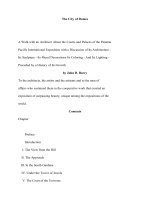The History of Insects potx
Bạn đang xem bản rút gọn của tài liệu. Xem và tải ngay bản đầy đủ của tài liệu tại đây (904.57 KB, 103 trang )
The Project
Gutenberg eBook,
The History of
Insects, by
Unknown
This eBook is for the use of
anyone anywhere at no cost and
with
almost no restrictions
whatsoever. You may copy it, give
it away or
re-use it under the terms of the
Project Gutenberg License
included
with this eBook or online at
www.gutenberg.net
Title: The History of Insects
Author: Unknown
Release Date: January 25, 2004
[eBook #10834]
Language: English
Character set encoding: US-
ASCII
***START OF THE PROJECT
GUTENBERG EBOOK THE
HISTORY OF INSECTS***
E-text prepared by Internet
Archive Children's Library,
Garrett Alley,
and the Project Gutenberg
Online Distributed
Proofreading Team
OF INSECTS.
And God made every thing
that creepeth upon the earth.
Gen. 1. 25.
NEW-YORK:
PRINTED AND SOLD BY
SAMUEL WOOD,
At the Juvenile Book-store,
No. 357, Pearl-street.
1813.
Observe the insect race,
ordained to keep
The silent sabbath of a half
year's sleep!
Entom'd beneath the filmy web
they lie
And wait the influence of a
kinder sky;
When vernal sunbeams pierce
the dark retreat,
The heaving tomb distends with
vital heat;
The full formed brood,
impatient of their cell,
Start from their trance, and
burst their silken shell.
BARBAULD.
1. THE HISTORY OF
INSECTS.
2. ELEPHANT-BEETLE.
3. GRASSHOPPER.
4. CRICKET.
5. LOCUST.
6. FLEA.
7. LOUSE.
8. ITCH MITE.
9. SCORPION.
10. ANTS.
11. HONEY-BEE.
12. DRAGON FLY.
13. BUTTERFLY.
14. SPIDER.
15. SILK WORM
16. SAMUEL WOOD
THE HISTORY OF
INSECTS.
Insects are so called from a
separation in the middle of their
bodies, seemingly cut into two
parts, and joined together by a
small ligature, as we see in
wasps and common flies.
However small and
contemptible this class of beings
may appear, at first thought,
yet, when we come to reflect,
and carefully investigate, we
shall be struck with wonder and
astonishment, and shall
discover, that the smallest gnat
that buzzes in the meadow, is
as much a subject of admiration
as the largest elephant that
ranges the forest, or the hugest
whale which ploughs the deep;
and when we consider the least
creature that we can imagine,
myriads of which are too small
to be discovered without the
help of glasses, and that each of
their bodies is made up of
different organs or parts, by
which they receive or retain
nourishment, &c. with the
power of action, how natural
the exclamation, O "Lord, how
manifold are thy works! in
wisdom hast thou made them
all." Under these considerations,
that they are the work of the
same great, good, and Almighty
hand that formed us, and that
they are all capable of feeling
pleasure and pain, surely every
little child, as well as older
person, ought carefully to avoid
every kind of cruelty to any
kind of creature, great or small.
The supreme court of
Judicature at Athens punished a
boy for putting out the eyes of a
poor bird; and parents and
masters should never overlook
an instance of cruelty to any
thing that has life, however
minute, and seemingly
contemptible the object may be.
"I would not enter on my list of
friends
(Though grac'd with polish'd
manners, and fine sense,
Yet wanting sensibility) the man
Who needlessly sets foot upon a
worm."
COWPER.
ELEPHANT-BEETLE.
The elephant-beetle is the
largest of this kind hitherto
known, and is found in South
America, particularly in Guiana,
about the rivers Surinam and
Oroonoko. It is of a black
colour, and the whole body is
covered with a shell, full as
thick and as strong as that of a
small crab. There is one
preserved in the museum that
measures more than six inches.
GRASSHOPPER.
Grasshoppers are too common
to need description, as they
abound almost wherever there
is green grass. One summer
only is their period of life; they
are hatched in the spring, and
die in the fall; previous to
which, they deposite their eggs
in the earth, which the genial
warmth of the next season
brings to life. They are food for
many of the feathered race.
CRICKET.
There are two classes of
crickets: viz. the field cricket,
and the house cricket; the latter
inhabits warm places, the holes
of the hearth, &c. from whence
we hear its notes, which are
agreeable: it is said, that they
are purchased by some, and
kept in a kind of cage, for the
sake of their music. Field
crickets inhabit the meadows,
and subsist on roots, &c. as
does another species, called the
mole cricket.
LOCUST.
There are different kinds of the
locust; those we are acquainted
with, in this country, are
represented in the above cut. In
some seasons, they are scarcely
heard at all; in others, they are
more numerous. About the
middle or latter part of summer,
we hear them among the leaves
of the trees: their notes, which
are continued about the space
of one minute, are loud at the
beginning, and grow lower and
lower, till they cease; when
they immediately fly to another
tree, begin again, and end in the
same way, and so on.
In the eastern countries, a kind
or kinds of locust, at different
periods, have been very
numerous, and have done
abundance of damage. In the
year 1650, a cloud of locusts
entered Russia, in three
different places; and from
thence spread over Poland and
Lithuania; the air was darkened,
and the earth covered, in some
places, to the depth of four feet;
the trees bent with heir weight,
and the damage sustained
exceeded computation. Locusts
were among the plagues of
Egypt: sec Exodus, x. 15.









